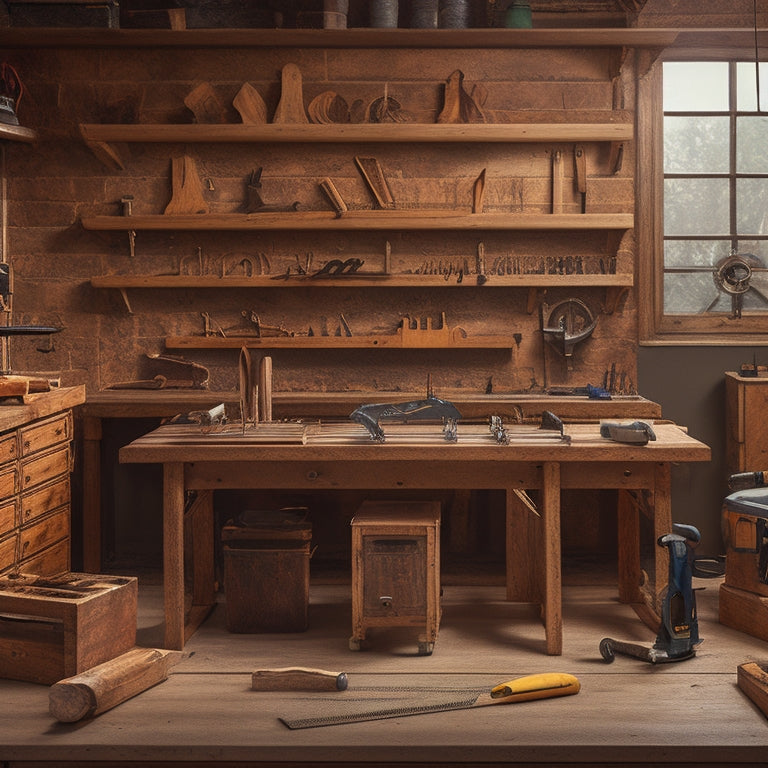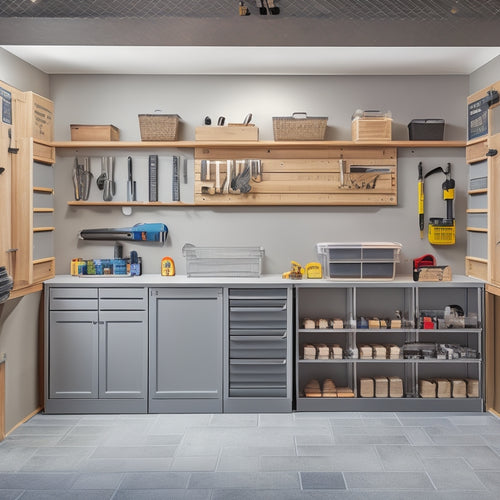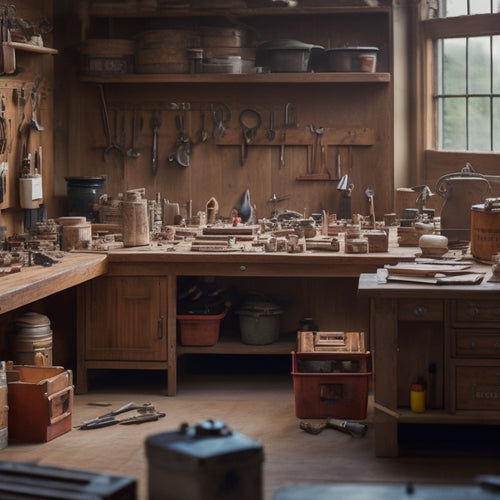
7 Essential Tools for Woodworking Project Success
Share
You're already skilled at woodworking, but to take your projects to the next level, you need the right tools. Start by mastering project planning software to visualize and plan your projects in 3D. Then, schedule tasks with ease by allocating them to specific days and prioritizing critical tasks. Organize your project components effectively using a sorting system, clear labeling, and efficient tool organization. Accurately estimate material requirements by calculating quantity, waste, and defects. With these essential tools, you'll be well on your way to achieving woodworking project success. Now, discover the remaining tools to make sure your projects come together seamlessly.
Key Takeaways
• Mastering project planning software helps identify potential issues early, creates detailed cut lists, and tracks timelines for woodworking project success.
• Effective task scheduling involves allocating tasks to specific days, prioritizing critical tasks, and breaking down large tasks into smaller chunks.
• Organizing project components involves implementing a well-designed sorting system, labeling components clearly, and optimizing the workspace for efficiency.
• Accurate material estimation is crucial, considering material waste, defects, and thickness to calculate total square footage needed.
• Utilizing tools like Gantt charts and buffer time helps woodworkers stay on top of deadlines and adapt to unexpected setbacks.
Mastering Project Planning Software
By incorporating project planning software into your workflow, you'll be able to visualize your woodworking project in 3D, create detailed cut lists, and identify potential issues before they become costly mistakes.
With project visualization tools, you can get a clear understanding of your project's scope and complexity, ensuring that you're well-prepared for each stage of the project.
Additionally, timeline tracking features allow you to stay on top of deadlines and milestones, keeping your project on schedule.
When it comes to project management software, Gantt chart integration is a game-changer. This feature enables you to break down complex projects into manageable tasks and track progress in real-time.
You'll be able to identify dependencies, allocate resources, and make data-driven decisions to optimize your workflow.
By leveraging these powerful tools, you'll be able to streamline your project planning process, reduce errors, and increase productivity.
With project planning software, you'll be able to focus on what matters most – bringing your woodworking vision to life.
Scheduling Tasks With Ease
With your project plan in place, you can now allocate specific tasks to specific days on your calendar, guaranteeing a seamless workflow and minimizing downtime between tasks. This is where task prioritization comes into play, as you'll need to determine which tasks are most critical to the project's success.
To do this, consider the project timelines and identify the tasks that have the greatest impact on the overall project schedule.
Here are some tips to help you schedule tasks with ease:
-
Break down large tasks into smaller, manageable chunks to avoid feeling overwhelmed
-
Identify tasks that can be completed concurrently to maximize your productivity
-
Schedule tasks according to their priority and deadlines
-
Leave some buffer time in your schedule for unexpected setbacks or delays
-
Review and adjust your schedule regularly to make sure you're on track to meet your project deadlines
Organizing Project Components Effectively
As you tackle your woodworking project, you'll quickly realize that organizing project components is essential to staying on track and meeting your deadline. You'll need to develop a system that allows you to efficiently sort, identify, and access each component as you need it.
Component Sorting Systems
You'll greatly reduce project delays and frustration by implementing a well-designed component sorting system that keeps all your woodworking project parts organized and easily accessible. This system is pivotal for efficient inventory management, ensuring that you can quickly locate and retrieve the components you need.
A well-organized system also prevents mistakes, such as misplacing or mixing up similar parts.
Here are some essential features to include in your component sorting system:
-
Separate bins for each project: Keep all the parts for a specific project in one place, making it easy to access and work on multiple projects simultaneously.
-
Clear labels and signs: Use clear and descriptive labels to identify the contents of each bin or storage container.
-
Categorize similar parts: Group similar parts together, such as all the screws or hinges, to simplify the search process.
-
Store small parts in small containers: Use small containers or dividers to store small parts, preventing them from getting lost or mixed up.
-
Keep frequently used parts front and center: Store your most frequently used parts in an easily accessible location to save time and effort.
Labeling and Identification
Develop a labeling system that accurately identifies each component, guaranteeing you can pinpoint the exact part you need in an instant, and thereby streamlining your workflow. This system will help you quickly locate the specific piece you need, saving you time and reducing frustration. Use labels that clearly indicate the component's name, type, and quantity, making it easy to distinguish between similar parts.
Effective labeling also enables you to implement efficient tool organization and inventory tracking. By labeling your tools and materials, you can easily identify what you have in stock and what needs to be replenished. This guarantees you're always prepared for your next project, and you can avoid costly delays due to missing components.
When creating your labeling system, consider using color-coding, categorization, and clear, concise language. This will help you quickly identify patterns and connections between components, making it easier to plan and execute your project.
With a well-organized labeling system, you'll be able to focus on the creative aspects of woodworking, knowing that your components are easily accessible and accurately identified.
Workspace Optimization
With a well-organized labeling system in place, you can now turn your attention to optimizing your workspace by strategically arranging project components to maximize efficiency and reduce clutter. A well-optimized workspace is vital for woodworking project success, as it enables you to focus on the task at hand and avoid wasting time searching for misplaced tools or materials.
To achieve an optimized workspace, consider the following essential elements:
-
Ergonomic furniture: Invest in a comfortable, adjustable chair and a sturdy workbench that allows you to work at a comfortable height.
-
Lighting solutions: Install task lighting, such as under-cabinet lights or a magnifying lamp, to illuminate your work area and reduce eye strain.
-
Tool organization: Use pegboards, tool chests, or hooks to keep frequently used tools within easy reach.
-
Material storage: Designate a specific area for storing lumber, sheet goods, and other project materials, keeping them organized and easily accessible.
-
Work surface protection: Use a durable work surface, such as a butcher block or a sacrificial table top, to protect your workbench from damage and spills.
Estimating Material Requirements Accurately
When you're about to start a woodworking project, precise material estimation is vital to avoid costly mistakes. You'll need to calculate the exact amount of materials required, optimize lumber sizes to reduce waste, and develop strategies to minimize scrap.
Material Quantity Calculation
You'll need to accurately calculate the quantity of materials required for your woodworking project to avoid costly errors and make certain you have enough stock on hand. This pivotal step guarantees you're not left with excess materials or, worse, not enough to complete the project.
To get it right, you'll need to take into account the design specifications, measurements, and material types.
Here are some essential considerations to keep in mind:
-
Measure your design components meticulously to avoid errors
-
Account for material waste and defects
-
Consider the thickness, width, and length of each material
-
Calculate the total square footage of materials needed
-
Double-check your calculations to avoid errors
Lumber Size Optimization
To optimize lumber size and estimate material requirements accurately, calculate the most efficient cutting layouts for each component, taking into account standard lumber dimensions and your project's specific design constraints. This guarantees you're using the right amount of lumber for each piece, minimizing waste and reducing the risk of running out mid-project.
Create a detailed cut list to help you visualize the most efficient way to cut your lumber. This list should include the quantity and size of each piece, as well as any specific cuts or angles required.
When selecting boards, consider the grain direction, knots, and other imperfections that could affect the final product. By choosing the right boards for each component, you can secure a professional-looking finish and minimize the need for costly repairs.
Waste Reduction Strategies
By accurately estimating material requirements, you'll eliminate the risk of buying too much or too little lumber, and strategically planning your cuts will help you sidestep costly mistakes. This is pivotal in waste reduction strategies, as it allows you to optimize your lumber usage and minimize scraps.
To take it a step further, consider the following efficient layout design techniques:
- Use a cut list to organize your cuts and minimize waste
- Opt for rectangular shapes to reduce offcuts
- Plan your cuts to maximize the use of each board
- Cut smaller pieces from larger scraps to reduce waste
- Consider using a 'scrap first' approach, where you use leftover materials for smaller cuts before moving on to fresh lumber
Streamlining Workflows With Templates
Create a library of reusable templates to standardize repetitive tasks and eliminate unnecessary guesswork in your woodworking projects. By doing so, you'll save time and energy, allowing you to focus on the creative aspects of your craft.
Template customization is key to streamlining your workflow. Tailor your templates to fit specific project types, such as cabinetry or furniture making, to ensure precision and uniformity. This will also enable you to track project progress efficiently, identifying potential bottlenecks and areas for enhancement.
With templates in place, you'll be able to allocate resources more effectively, reducing waste and optimizing your workflow. You'll also be able to easily replicate successful projects, making it simpler to scale up or repeat a design.
Additionally, templates will help you maintain a record of your projects, allowing you to analyze and refine your techniques over time. By integrating templates into your workflow, you'll be able to work smarter, not harder, and take your woodworking projects to the next level.
Visualizing Project Progress Clearly
You'll be amazed at how a well-organized visual project tracker can revolutionize your woodworking workflow, providing a clear snapshot of progress and helping you identify potential roadblocks before they become major issues. By utilizing progress tracking and visualization techniques, you'll be able to stay on top of your project's development and make adjustments as needed.
Here are some essential visualization tools to incorporate into your workflow:
-
Gantt charts to illustrate your project timeline and dependencies
-
Kanban boards to visualize task progression and workflow
-
Mind maps to organize ideas and concepts
-
Flowcharts to diagram complex processes
-
Burn-down charts to track task completion and remaining work
Managing Time Efficiently Always
With your project's progress clearly visualized, it's time to turn your attention to managing the time it takes to complete each task, ensuring you're working efficiently and making the most of your time in the workshop. Effective time management is essential to meeting project deadlines and maintaining productivity. To optimize your time, prioritize tasks based on their complexity, urgency, and dependencies.
| Task Characteristic | Time Allocation |
|---|---|
| High complexity, high urgency | Allocate more time for planning and execution |
| Low complexity, low urgency | Allocate less time, consider delegating or batching |
| High complexity, low urgency | Allocate sufficient time for planning and execution, with flexibility for adjustments |
Frequently Asked Questions
How Do I Prevent Woodworking Project Scope Creep?
To prevent scope creep, you'll define your project's scope upfront, prioritizing tasks and allocating resources accordingly. Stick to your plan, manage your time effectively, and avoid adding new features without reassessing and adjusting your scope.
What Safety Equipment Is Essential for Woodworking Projects?
You'll likely wonder if safety equipment is just a myth, but research proves it's essential. When working with power tools, you must wear safety goggles to shield your eyes from debris and dust masks to prevent respiratory issues.
Can I Repurpose Old Woodworking Tools to Save Money?
You can breathe new life into old woodworking tools through tool restoration, a budget-friendly approach that saves you money. Get creative with upcycling and repurpose old tools in a cost-effective way that's both eco-friendly and smart.
How Do I Handle Unexpected Project Delays or Setbacks?
"Take a deep breath, just like a medieval knight preparing for battle, and tackle those unexpected project delays with solid time management and problem-solving skills, allocating resources wisely to get your project back on track."
What Are the Best Ways to Store and Maintain Woodworking Tools?
You'll extend the life of your tools by implementing a thoughtful tool organization system and following maintenance tips like regular cleaning, lubrication, and sharpening to prevent rust and dullness.
Related Posts
-

Essential Steps for Garage Storage System Design
You're about to change your cluttered garage into an organized haven by following a structured approach to garage sto...
-

Top Wrench Tool Box Sets for Every Mechanic
You're looking for high-quality wrench tool box sets that cater to your specific needs as a mechanic. From top-rated ...
-

Top 7 Parts Tray Organizers for Productivity
You can optimize your workspace and enhance productivity with the right parts tray organizer, which can help you cate...


